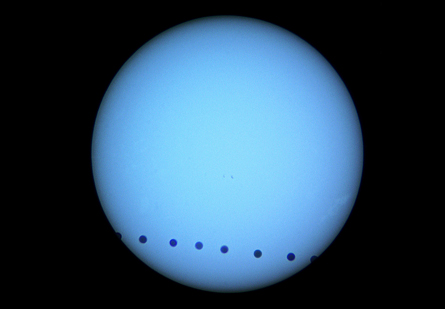On June 5, skywatchers will have their last chance to glimpse a rare celestial spectacle, a “transit of Venus,” in which the planet passes directly between Earth and the sun. Venus will take six hours to march across the star’s face, appearing as an inky black dot in silhouette against the looming solar disk.

After that, the sun-shadowed Venusian outline will disappear until 2117. Because the planet’s orbit is slightly off-kilter, its solar transits come in pairs spaced eight years apart, with more than 100 years between pairs.
During the most recent transit pair of 1874 and 1882, observers around the world focused on triangulating the Earth-sun distance. They tried to time precisely when Venus entered and exited the sun’s disk, so they could calculate the size of the sun (a complicated endeavour, it turns out, since an optical effect that blurred the boundary between planet and sun muddied the timing measurements). The most recent transit happened in 2004 — only the sixth such performance seen through telescopes — and it revealed that large portions of the Venusian atmosphere are visible to Earthly observers.
Now, scientists are hoping not only to study Venus itself during the transit, but are using the crossing to inform observations of far-off exoplanets that similarly betray their presence by passing between their star and Earth. “Over 100 years ago, astronomers couldn’t have anticipated this transit question,” says astronomer Jay Pasachoff of Williams College in Williamstown, Mass., who will observe the transit from Hawaii.
Pasachoff and his colleagues are also deploying nine instruments to locations including Japan, Kazakhstan, and Norway, to study the sunlight filtered through Venus’ toxic clouds.
During the transit the sun will act as a giant light bulb, illuminating Venus’ upper atmosphere and providing information about temperature and aerosols across the planet. The orbiting Venus Express spacecraft can gather data only about isolated portions of the swirling sulfuric acid clouds, begging the question of how the shroud behaves globally. “As temperatures and winds are closely linked, those measurements will be fed into models that aim to explain the exotic dynamics of the Venusian atmosphere,” says astronomer Thomas Widemann of the Paris Observatory, who will join Venus Express team members in Svalbard, Norway to observe the transit against the midnight sun.
When Earth’s little sister passes before the solar backdrop, its planetprint produces the type of dimming that occurs when exoplanets periodically block their stars’ light. Astronomers have been able to study the atmospheres of Jupiter-sized exoplanets, but similar observations of terrestrial planets are still a thing of the future.
Gathering data about a known planet – Venus – will help ground those future observations, says astronomer Paolo Tanga at the Cote d’Azur Observatory in Nice, France. “Maybe one day we will be able to measure the same light that is filtered from the atmospheres of exoplanets – exo-Venuses and exo-Earths,” says Tanga, who will be in Arizona for the transit.
But such observations aren’t so simple. “Big mirrors and sensitive detectors are not good things to point at the sun,” explains planetary astronomer Heather Knutson of Caltech. Instead astronomers will use the Hubble Space Telescope to capture sunlight reflected off the face of the moon during the transit. In that light are signatures of chemical compounds in the Venusian atmosphere, Knutson says. “It’s the first time we can make this measurement for a truly terrestrial planet.”







